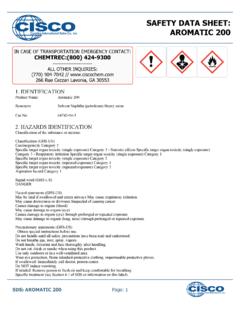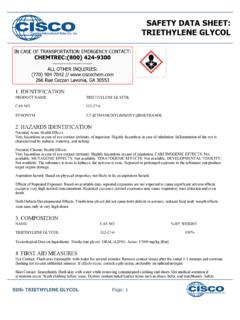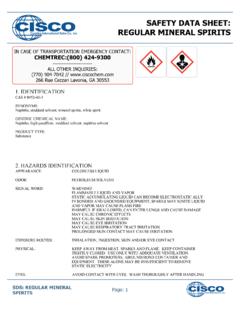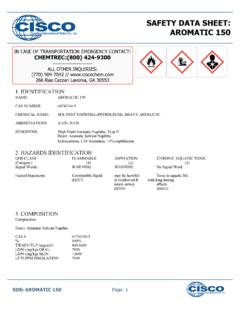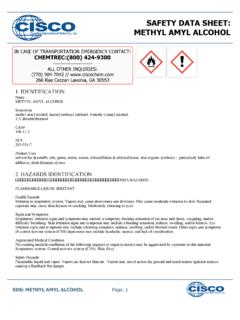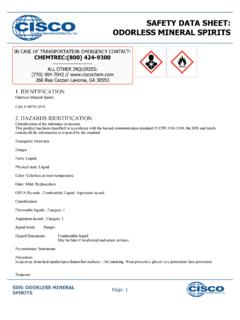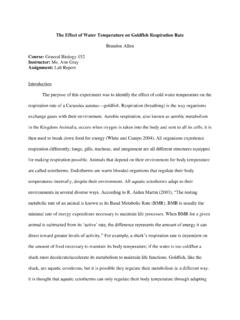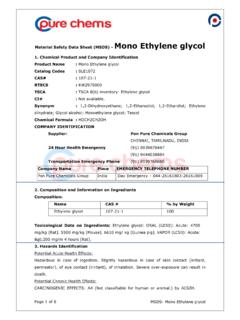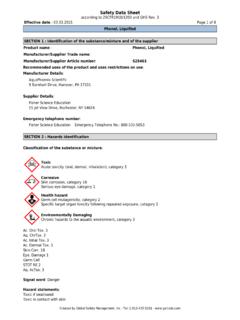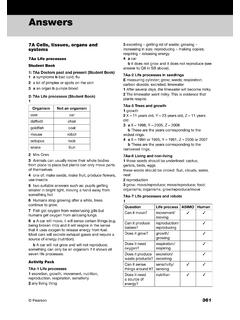Transcription of SAFETY DATA SHEET: HEPTANE
1 SAFETY data SHEET: HEPTANE1. IDENTIFICATIONPRODUCT NAME: HeptaneSynonym: Dipropyl methane; Heptyl hydrideChemical Name: HeptaneChemical Formula: C7 H16 PRODUCT USE: Solvent2. HAZARDS IDENTIFICATIONEMERGENCY OVERVIEW: Flammable liquid and vapor. Colorless liquid. Toxic byinhalation and HEALTH HAZARDSSKIN: Irritant. Prolonged contact may cause dermatitis. Can be absorbed through skin producing systemiceffects similar to : : Irritating to the respiratory tract. Inhalation of fumes and vapors may cause headache, dizziness, drowsiness,unconsciousness, and other central nervous system effects including coma and : Ingestion can cause nausea, vomiting, diarrhea, stomach pain, headache, intoxication, and heart EFFECTS: A gasoline taste may occur and persist for several hours after found on one of the OSHA designated carcinogen lists are listed NAME NTP STATUS IARC STATUS OSHA LISTNo ingredients listed in this COMPOSITIONC omposition:NameCAS #% by Weight{n-}heptane142-82-5 Toxicological data on Ingredients: n- HEPTANE : VAPOR (LC50): Acute: 103000 mg/m 4 hours [Rat].
2 100IN CASE OF TRANSPORTATION EMERGENCY CONTACT:CHEMTREC:(800) 424-9300-----------------------ALL OTHER INQUIRIES:(770) 904-7042 // Rue Cezzan Lavonia, GA 30553 Page: 1 SDS: HEPTANE4. FIRST AID MEASURESSKIN: Rinse affected area with mild soap and water solution until no evidence of chemical remains. Cover the irritated skin with anemollient. Remove contaminated clothing and shoes. Wash clothing before reuse. Thoroughly clean shoes before reuse. Get : Rinse eye(s) immediately with large amounts of water. Consult a : Remove from exposure area to fresh air. If victim is not breathing administer artificial respiration according to yourlevel of training and obtain professional medical assistance Inhalation:Evacuate the victim to a safe area as soon as possible. Loosen tight clothing such as a collar, tie, belt or waistband.
3 If breathing isdifficult, administer oxygen. If the victim is not breathing, perform mouth-to-mouth resuscitation. Seek medical : Do not induce vomiting unless advised to do so by a qualified medical professional. Never give anything by mouth toan unconscious person. Aspiration hazard if swallowed- can enter lungs and cause damage. Loosen tight clothing such as a collar,tie, belt or waistband. Get medical TO PHYSICIAN: No specific antidote. Treat supportively and FIRE FIGHTING MEASURESF lammability of the Product: Temperature: C (399 F) - 223 C (433 F)Flash Points: CLOSED CUP: -4 C ( F). (TAG) OPEN CUP: C (30 F).Flammable Limits: LOWER: UPPER: of Combustion: These products are carbon oxides (CO, CO2).Fire Hazards in Presence of Various Substances: Highly flammable in presence of open flames and sparks, of Hazards in Presence of Various Substances:Risks of explosion of the product in presence of mechanical impact: Not available.
4 Risks of explosion of the product in presence ofstatic discharge: Not available. Slightly explosive in presence of Fighting Media and Instructions:Flammable liquid, insoluble in water. SMALL FIRE: Use DRY chemical powder. LARGE FIRE: Use water spray or Remarks on Fire Hazards:Flaming occurs when liquid chlorine in n- HEPTANE is added to added to red phosphorous. Vapors may form explosive mixtures withair. Vapor may travel considerable distance to source of ignition and flash Remarks on Explosion Hazards: Vapors may form explosive mixtures in ACCIDENTAL RELEASE MEASURESS mall Spill: Absorb with an inert material and put the spilled material in an appropriate waste Spill:Flammable liquid, insoluble in water. Keep away from heat. Keep away from sources of ignition. Stop leak if without risk. Absorbwith DRY earth, sand or other non-combustible material.
5 Do not get water inside container. Do not touch spilled material. Prevententry into sewers, basements or confined areas; dike if needed. Call for assistance on disposal. Be careful that the product is notpresent at a concentration level above TLV. Check TLV on the MSDS and with local : 2 SDS: HEPTANES pills and releases may have to be reported to Federal and/or local HANDLING AND STORAGENORMAL HANDLING: (Always wear recommended personal protective equipment.)Protective Neoprene or natural rubber gloves and apron are recommended. Goggles and/or face shield should be worn to guardagainst splashing. Keep away from heat and open flame. Avoid contact with skin, eyes and clothing. Contaminated clothing shouldbe decontaminated using dedicated spill clean-up containers, plenty of water, and detergent prior to conventional laundering in homelaundry RECOMMENDATIONS:Store in an area designed for storage of flammable liquids.
6 (OSHA 29 CFR )Store full or partially full containers in an upright position, tightly closed in a cool, dry, well ventilated facility designed forflammable liquids. Store away (segregate) from acids, oxidizers, and explosives. Handle containers in a safe manner using properequipment and avoiding damage to the liquid and vapor. Once liquid solvent has been completely dispensed, containers which appear empty should behandled in the same manner as when they were full of liquid EXPOSURE CONTROLS AND PERSONAL PROECTIONE ngineering Controls:Provide exhaust ventilation or other engineering controls to keep the airborne concentrations of vapors below their respectivethreshold limit value. Ensure that eyewash stations and SAFETY showers are proximal to the work-station Protection: SAFETY glasses. Lab coat. Vapor respirator.
7 Be sure to use an approved/certified respirator or equivalent. Protection in Case of a Large Spill:Splash goggles. Full suit. Vapor respirator. Boots. Gloves. A self contained breathing apparatus should be used to avoid inhalation ofthe product. Suggested protective clothing might not be sufficient; consult a specialist BEFORE handling this Limits:TWA: 500 (ppm) from OSHA (PEL) [United States] TWA: 2000 (mg/m3) from OSHA (PEL) [United States] TWA: 350 CEIL:1800 (mg/m3) from NIOSH [United States] TWA: 85 CEIL: 440 (ppm) from NIOSH [United States] TWA: 400 STEL: 500 (ppm)from ACGIH (TLV) [United States] TWA: 500 (ppm) [United Kingdom (UK)] TWA: 400 STEL: 500 (ppm) [Canada] TWA: 1640 STEL: 2049 (mg/m3) [Canada] TWA: 400 STEL: 500 (ppm) [Belgium] TWA: 200 (ppm) [Norway] TWA: 300 STEL: 500 (ppm)[Finland] TWA: 500 (ppm) [Austria]Consult local authorities for acceptable exposure PHYSICAL AND CHEMICAL PROPERTIESP hysical state and appearance: : Hydrocarbon.
8 Gasoline-likeTaste: Not Weight: g/moleColor: Clear (1% soln/water): Not Point: ( F) Melting Point: C ( F)Critical Temperature: Not Gravity: (Water = 1)Page: 3 SDS: HEPTANEV apor Pressure: kPa (@ 20 C)Vapor Density: (Air = 1)Volatility: Not Threshold: 150 ppmWater/Oil Dist. Coeff.: The product is more soluble in oil; log(oil/water) = (in Water): Not Properties: See solubility in water, diethyl ether, :Soluble in diethyl ether, acetone. Insoluble in cold water. Soluble in alcohol. Solubility in Chloroform, Petroleum Ether, Ether,Acetone: >10% Floats on STABILITY AND REACTIVITYS tability: The product is Temperature: Not of Instability: Heat, ignition sources (flames, sparks), incompatible materialsIncompatibility with various substances: Reactive with oxidizing : Not considered to be corrosive for metals and Remarks on Reactivity: Not Remarks on Corrosivity: Not : Will not TOXICOLOGICAL INFORMATIONR outes of Entry: Absorbed through skin.
9 To Animals:WARNING: THE LC50 VALUES HEREUNDER ARE ESTIMATED ON THE BASIS OF A 4-HOUR EXPOSURE. Acutetoxicity of the vapor (LC50): 103000 mg/m3 4 hours [Rat].Chronic Effects on Humans:May cause damage to the following organs: lungs, peripheral nervous system, upper respiratory tract, skin, central nervous system(CNS).Other Toxic Effects on Humans: Slightly hazardous in case of skin contact (irritant), of ingestion, of Remarks on Toxicity to Animals: Not Remarks on Chronic Effects on Humans: Not Remarks on other Toxic Effects on Humans:Acute Potential Health Effects: Skin: Causes skin irritation. It can be absorbed through the skin. Eyes: Contact with liquid may causeeye irritation. Contact with vapors is not expected to cause eye irritation. Inhalation: Inhalation of vapor or mist causes respiratorytract and mucous membrane irritation.
10 It can affect behavior/central nervous system and cause central nervous system effects (mildexcitement followed CNS depression which is characterized by headache, nausea, dizziness, hilarity, hallucinations, lightheadness,distorted perceptions, convulsions, weakness, loss of judgement and coordination, narcosis, semi-conciousness, coma and death atPage: 4 SDS: HEPTANE higher doses). It may cause cardiac effects (irregular heartbeat/cardiac arrhythmias, or heart to stop beating), and pulmonary is readily absorbed by the inhalation route. Ingestion: Causes gastrointestinal tract irritation with nausea, vomiting, swelling of theabdomen. Aspiration into the lungs can produce chemical can also affect behavior/central nervous system with symptoms paralleling those of inhalation. Chronic Potential Health Effects:Skin: Prolonged or repeated skin contact can defat the skin and product irritation and dermatitis.
